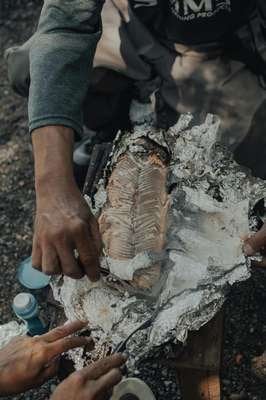The fish in your kitchen might be at risk of a parasite invasion. Find out why!
By
Danielle F.
- Replies 5
For many Australians, there's nothing quite like the satisfaction of cooking up a fresh catch from a day out on the water.
However, a concerning trend has emerged that could turn that delightful dinner into a culinary catastrophe.
Professional anglers and fish enthusiasts are alarmed by a 'dramatic rise' in parasites causing havoc in the kitchen.
The phenomenon, known as mushy fish syndrome, is a problem that can ruin a meal.
When the fish flesh infected by microscopic parasites is exposed to heat, they begin to liquefy the flesh, leaving a texture akin to mashed potatoes.
The results will leave an unappetising dish on dinner plates across many homes.
Craig McGill, a seasoned tour guide with a wealth of knowledge about the fish in Sydney Harbour, has sounded the alarm on this growing issue.
‘I’ve seen more fish with it in the last two seasons than I’ve seen in the previous 30 years,’ he said.
This uptick in parasitic activity has emerged in northern New South Wales and southern Queensland waters and is moving further south towards Sydney.
McGill has also noticed one possible factor contributing to this phenomenon.
‘This year the water was probably the warmest I've ever seen it,’ he added.
‘There was another warm water event back in 1999-2000 and it was prominent then too.’
McGill experienced this firsthand about a month ago when he cooked a kingfish.
Despite using different cooking methods, the result was still a ‘horrid experience’.
‘If you’re just cooking it in a pan or on a barbecue it’ll present alright on the plate, but it will then just turn to the consistency of mashed potatoes,’ he shared.
‘I've cooked it Sous vide—when you put it in a bag and immerse it in water for a period of time—and I basically pulled the bag out and it was full of liquid.’
Other species at risk include amberjack and mahi-mahi, both found further offshore.
The issue is particularly problematic for home cooks, as testing portions is uncommon unlike in restaurant kitchens.
The culprits behind this mushy fish syndrome are Kudoa and Unicapsula—pathogens that release a flesh-digesting enzyme.
This process leads to myoliquefaction, or the breakdown of muscle tissue.
While unappetising, these parasites do not infect humans.
However, according to a 2014 report, Kudoa has been linked to several allergic reactions and a case of food poisoning.
The Fisheries Research and Development Corporation is actively working on a solution to this problem by developing a rapid test to detect these parasites in fish.
For home cooks, consider the source of your seafood and be aware of the potential for parasite infection.
It's good to familiarise yourself with the signs of mushy fish syndrome to avoid serving affected fish to family and friends.

Have you encountered mushy fish syndrome in your culinary adventures? Share your experiences and tips for selecting the best fish in the comments below.
However, a concerning trend has emerged that could turn that delightful dinner into a culinary catastrophe.
Professional anglers and fish enthusiasts are alarmed by a 'dramatic rise' in parasites causing havoc in the kitchen.
The phenomenon, known as mushy fish syndrome, is a problem that can ruin a meal.
When the fish flesh infected by microscopic parasites is exposed to heat, they begin to liquefy the flesh, leaving a texture akin to mashed potatoes.
The results will leave an unappetising dish on dinner plates across many homes.
Craig McGill, a seasoned tour guide with a wealth of knowledge about the fish in Sydney Harbour, has sounded the alarm on this growing issue.
‘I’ve seen more fish with it in the last two seasons than I’ve seen in the previous 30 years,’ he said.
This uptick in parasitic activity has emerged in northern New South Wales and southern Queensland waters and is moving further south towards Sydney.
McGill has also noticed one possible factor contributing to this phenomenon.
‘This year the water was probably the warmest I've ever seen it,’ he added.
‘There was another warm water event back in 1999-2000 and it was prominent then too.’
Despite using different cooking methods, the result was still a ‘horrid experience’.
‘If you’re just cooking it in a pan or on a barbecue it’ll present alright on the plate, but it will then just turn to the consistency of mashed potatoes,’ he shared.
‘I've cooked it Sous vide—when you put it in a bag and immerse it in water for a period of time—and I basically pulled the bag out and it was full of liquid.’
Other species at risk include amberjack and mahi-mahi, both found further offshore.
The issue is particularly problematic for home cooks, as testing portions is uncommon unlike in restaurant kitchens.
The culprits behind this mushy fish syndrome are Kudoa and Unicapsula—pathogens that release a flesh-digesting enzyme.
This process leads to myoliquefaction, or the breakdown of muscle tissue.
While unappetising, these parasites do not infect humans.
However, according to a 2014 report, Kudoa has been linked to several allergic reactions and a case of food poisoning.
The Fisheries Research and Development Corporation is actively working on a solution to this problem by developing a rapid test to detect these parasites in fish.
For home cooks, consider the source of your seafood and be aware of the potential for parasite infection.
It's good to familiarise yourself with the signs of mushy fish syndrome to avoid serving affected fish to family and friends.
Key Takeaways
- A professional angler has reported a dramatic increase in parasites causing mushy fish syndrome in Australian waters.
- These parasites liquefy fish flesh when cooked, affecting the taste and texture.
- The rise in ocean temperatures is suspected to be contributing to the spread of these parasites, including towards Sydney.
- Although not harmful to humans, eating fish affected by these parasites can be an unpleasant experience.
- The Fisheries Research and Development Corporation is developing a rapid test to detect parasites.








